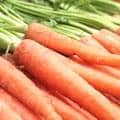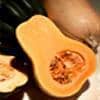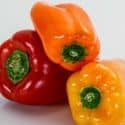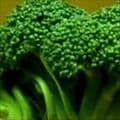Top 10 Foods High in Vitamin A

Vitamin A is a fat-soluble vitamin with several important functions in the body. It helps cells reproduce normally, is involved in healthy reproductive function and normal growth and development of the embryo and foetus. It is also required for the maintenance of good vision, immune system function, and keeping skin healthy.
A deficiency of vitamin A can lead to blindness and increased viral infection. However, deficiency is only considered a problem in developing countries, where it is a leading cause of blindness in children.
Overconsumption of vitamin A can lead to jaundice, nausea, loss of appetite, irritability, vomiting, and even hair loss.
About The Types of Vitamin A and Retinol Equivalents
- Vitamin A is available to humans in 2 ways: preformed vitamin A and carotenoids.
- Carotenoids, like beta-carotene, are found in plant foods and have to be converted by the body into vitamin A. (2)
- Preformed vitamin A is found in animal food sources like liver, meat, fish, and dairy. Like carotenoids, the preformed vitamin A also needs to be metabolized by the body into an active form of vitamin A. (2)
- In rare cases certain people cannot convert carotenoids to vitamin A and should consume vitamin A found in animal food sources or supplements. These people should see our lists of meats high in vitamin A, fish high in vitamin A, and dairy foods high in vitamin A.
- Solving the Vitamin A Problem: Since vitamin A comes in many forms, starting from July 2018 large US food producers will report vitamin A values in retinol activity equivalents (RAE) of vitamin A. The new daily value for Vitamin A RAE will be 900mcg per day. (2,3)
High vitamin A foods include sweet potatoes, carrots, fish (tuna), winter squashes, dark leafy greens, cantaloupe, lettuce, bell peppers, pink grapefruit, and broccoli. The current daily value (DV) for Vitamin A is 900mcg of retinol activity equivalents (RAEs).
Below is a list high vitamin A foods, click here for over 200 foods high in vitamin A, sortable by common serving size, 200 calorie serving size, or 100 gram serving size.
Foods High In Vitamin A
 1 Carrots
1 Carrots| Vitamin A (RAE) per Cup Cooked | Vitamin A (RAE) per 100g | Vitamin A (RAE) per 200 Calories |
|---|---|---|
| 1329mcg (148% DV) | 852mcg (95% DV) | 4869mcg (541% DV) |
A medium-sized carrot provides 44% DV of vitamin A.
 2 Tuna
2 Tuna| Vitamin A (RAE) in a 6oz Fillet | Vitamin A (RAE) per 100g | Vitamin A (RAE) per 200 Calories |
|---|---|---|
| 1287mcg (143% DV) | 757mcg (84% DV) | 823mcg (91% DV) |
Other Fish and Seafood High in Vitamin A
- 201% DV in a 5.5 oz fillet of eel
- 150% DV in 1 tsp of cod liver oil
- 36% DV in 20 small clams
- 24% DV in 3oz of cooked mackerel
See the complete list of fish high in vitamin A.
 3 Butternut Squash
3 Butternut Squash| Vitamin A (RAE) per Cup Cooked | Vitamin A (RAE) per 100g | Vitamin A (RAE) per 200 Calories |
|---|---|---|
| 1144mcg (127% DV) | 558mcg (62% DV) | 2790mcg (310% DV) |
Other Squash High in Vitamin A
- 212% DV in 1 cup of canned pumpkin
- 76% DV in 1 cup of hubbard squash
- 59% DV per cup of average winter squash
- 11% DV per cup of acorn squash
See the full list of vegetables high in vitamin A.
 4 Sweet Potato
4 Sweet Potato| Vitamin A (RAE) per Cup Baked | Vitamin A (RAE) per 100g | Vitamin A (RAE) per 200 Calories |
|---|---|---|
| 1096mcg (122% DV) | 961mcg (107% DV) | 2136mcg (237% DV) |
A medium-sized baked sweet potato provides 122% DV of vitamin A.
 5 Spinach
5 Spinach| Vitamin A (RAE) per Cup Cooked | Vitamin A (RAE) per 100g | Vitamin A (RAE) per 200 Calories |
|---|---|---|
| 943mcg (105% DV) | 524mcg (58% DV) | 4557mcg (506% DV) |
Other Dark Leafy Greens High in vitamin A
- 98% DV per cup of cooked kale
- 96% DV per cup of cooked mustard greens
- 80% DV per cup of cooked collards
- 60% DV per cup of cooked Swiss chard
- 40% DV per cup of cooked bok choy
See the full list of vegetables high in vitamin A.
 6 Cantaloupe
6 Cantaloupe| Vitamin A (RAE) per Cup | Vitamin A (RAE) per 100g | Vitamin A (RAE) per 200 Calories |
|---|---|---|
| 299mcg (33% DV) | 169mcg (19% DV) | 994mcg (110% DV) |
Other Fruits High in Vitamin A
- 17% DV in 1 cup of apricots
- 10% DV per cup of sliced mango
- 8% DV per cup of sliced papaya
See the full list of fruits high in vitamin A.
 7 Lettuce
7 Lettuce| Vitamin A (RAE) per Cup | Vitamin A (RAE) per 100g | Vitamin A (RAE) per 200 Calories |
|---|---|---|
| 205mcg (23% DV) | 436mcg (48% DV) | 5129mcg (570% DV) |
 8 Red Bell Peppers
8 Red Bell Peppers| Vitamin A (RAE) per Cup Cooked | Vitamin A (RAE) per 100g | Vitamin A (RAE) per 200 Calories |
|---|---|---|
| 198mcg (22% DV) | 147mcg (16% DV) | 1050mcg (117% DV) |
Cooked Green Bell Peppers provide 3% DV of Vitamin A per cup cooked.
 9 Pink Grapefruit
9 Pink Grapefruit| Vitamin A (RAE) per Cup | Vitamin A (RAE) per 100g | Vitamin A (RAE) per 200 Calories |
|---|---|---|
| 133mcg (15% DV) | 58mcg (6% DV) | 276mcg (31% DV) |
Note: Pink grapefruit provides about 30 times more vitamin A than white grapefruit. View the complete nutrition comparison of pink vs white grapefruit.
 10 Broccoli
10 Broccoli| Vitamin A (RAE) per Cup Cooked | Vitamin A (RAE) per 100g | Vitamin A (RAE) per 200 Calories |
|---|---|---|
| 120mcg (13% DV) | 77mcg (9% DV) | 440mcg (49% DV) |
Printable One Page Sheet

Health Benefits of Vitamin A
- Increased Protection from Bacterial and Viral Infections - Vitamin A is essential for healthy surface linings of the eyes, mucous membranes, respiratory, urinary, and intestinal tracts, which help protect the body against infection. (4,5,6)
- Proper Immune Functioning - Vitamin A regulates the immune system and plays a key role in making white blood cells which fight off infections in the body. (4,5,6)
- Cancer Protection (*Food Sources Only) - Studies suggest beta-carotene and vitamin A lower risk of many types of cancer. (7) This effect could mainly be from a diet high in vegetables and not from supplements. Vitamin A supplements and carotene supplements have been shown to increase risk and progression of lung cancer in smokers, or those with a high risk of lung cancer. (8,9,10)
- Better Eye Health and Protection Against Age-Related Macular Degeneration - Oxidative stress plays a role in macular degeneration (poor eye-sight in old age). Anti-oxidants including vitamin A, Lutein, and Zeaxanthin, are thought to play a roll in reducing macular degeneration and preserving good eye health into old age. (2)
Causes of Vitamin A Deficiency
- Young Children and Breast Feeding Women - Getting enough vitamin A is important for children's development. Deficiency is sometimes seen in developing countries. When breast feeding, both child and mother may become deficient in vitamin A. Xerophthalmia is a common sign of deficiency. Symptoms include dryness of the cornea and redness around the eye. (2)
- People With Cystic Fibrosis - CS Leads to a pancreatic disorder and improper absorption of fats. Vitamin A is absorbed via fat. When fat is not absorbed, vitamin A deficiency occurs. (2)
About the Data
Data for the curated food lists comes from the USDA Food Data Central Repository.
You can check our data against the USDA by clicking the (Source) link at the bottom of each food listing.
Note: When checking data please be sure the serving sizes are the same. In the rare case you find any difference, please contact us and we will fix it right away.
From the Nutrient Ranking Tool
Use the ranking tool links below to select foods and create your own food list to share or print.
- Foods High in Vitamin A, RAE
- Foods Low in Vitamin A, RAE
- Vegetables High in Vitamin A, RAE
- Fruits High in Vitamin A, RAE
- Vegetarian Foods High in Vitamin A, RAE
- Nuts High in Vitamin A, RAE
- Dairy High in Vitamin A, RAE
- Breakfast Cereals High in Vitamin A, RAE
- Fast Foods High in Vitamin A, RAE
View more nutrients with the nutrient ranking tool, or see ratios with the nutrient ratio tool.
Related
Data Sources and References
- U.S. Agricultural Research Service Food Data Central
- Office Of Dietary Supplements Fact Sheet: Vitamin A
- Dietary Supplement Label Database
- Semba RD. The role of vitamin A and related retinoids in immune function. Nutr Rev 1998;56:S38-48.
- Ross DA. Vitamin A and public health: Challenges for the next decade. Proc Nutr Soc 1998;57:159-65.
- Harbige LS. Nutrition and immunity with emphasis on infection and autoimmune disease. Nutr Health 1996;10:285-312.
- Fontham ETH. Protective dietary factors and lung cancer. Int J Epidemiol 1990;19:S32-S42.
- Albanes D, Heinonen OP, Taylor PR, Virtamo J, Edwards BK, Rautalahti M, Hartman AM, Palmgren J, Freedman LS, Haapakoski J, Barrett MJ, Pietinen P, Malila N, Tala E, Lippo K, Salomaa ER, Tangrea JA, Teppo L, Askin FB, Taskinen E, Erozan Y, Greenwald P, Huttunen JK. Alpha-tocopherol and beta-carotene supplement and lung cancer incidence in the alpha-tocopherol, beta-carotene cancer prevention study: Effects of baseline characteristics and study compliance. J Natl Cancer Inst 1996;88:1560-70.
- Redlich CA, Blaner WS, Van Bennekum AM, Chung JS, Clever SL, Holm CT, Cullen MR. Effect of supplementation with beta-carotene and vitamin A on lung nutrient levels. Cancer Epidemiol Biomarkers Prev 1998;7:211-14.
- Pryor WA, Stahl W, Rock CL. Beta carotene: from biochemistry to clinical trials. Nutr Rev 2000;58:39-53.
Try the recipe nutrition calculator, or daily meal planner.
Create a free account to log and track foods.
